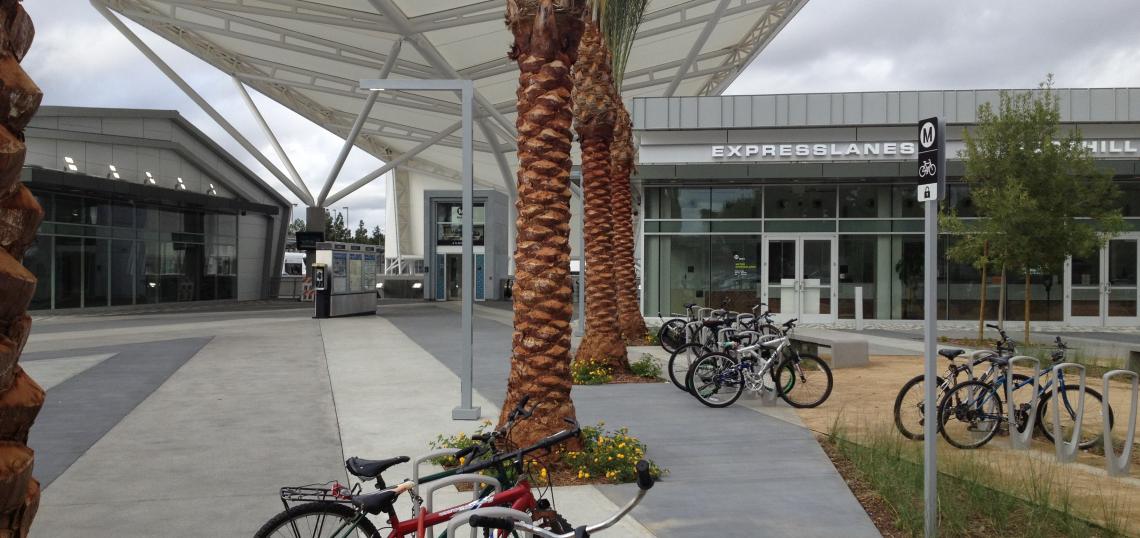Tomorrow, the Los Angeles Department of City Planning (LADCP) has scheduled a hearing to obtain testimony on potential changes to bicycle parking regulation in new developments.
Current policy, adopted in 2013, allows developers to swap out up to 20% of required automobile parking for less costly bicycle parking spaces. For new buildings located within 1,500 feet of a rail transit station, the percentage is increased to 30%.
Although the Bicycle Parking Ordinance has been used to great success, particularly by developers in the Downtown area, feedback to LADCP has lead to the conclusion that several components of the current regulations either lack clarity or require additional flexibility:
According to a notice posted to the LADCP website, proposed changes include:
- Establishes lower bicycle parking ratios for various types of senior housing.
- Allows required bicycle parking to be based on only a main use, where an accessory use comprises no more than 10 percent of a building or site.
- Defines “bus station” for the purpose of establishing proximity to transit for calculating automobile parking replacement.
- States that residential projects need only contain the required number of restricted affordable units for a density bonus to qualify for 30% auto parking replacement, without applying for a density bonus incentive(s).
- Discontinues the separate residential and commercial bicycle parking ratios for hotels, motels, and apartment hotels. Requires one long-term and one short-term bicycle parking space for every ten guest rooms
- Establishes rules for counting bicycle share docks toward required bicycle parking, as follows: (1)Provides definitions for “Bicycle Share Dock," “Bicycle Share Service Provider,” and “Bicycle Share Station"; (2) Allows bicycle share docks located on private property to count toward short-term bicycle parking requirements; (3) Allows up to 4 bicycle share docks to be counted toward short-term bicycle parking requirements if they are located within 500 feet of the subject property. (4) Allows bicycle share docks to count toward auto parking replacement consistent with current limitations.
- Establishes lower automobile parking requirements for affordable housing, senior housing (including elder care), and special needs housing near transit consistent with State law, and states that the replacement of automobile parking with bicycle parking may not result in fewer automobile spaces than allowed by State law.
Changes to the rules governing the location of bicycle parking include:
- Revises location criteria for long-term bicycle parking to allow greater flexibility, establishing three options, in order of preference: (1) Ground level with convenient access to the street and building lobby; (2) In automobile parking area, either on pedestrian entry level or with elevator/ramp access; (3)One level above or below ground level with elevator/ramp access.
- Revises location criteria for short-term bicycle parking to allow greater flexibility, as follows: (1) Allows short-term bicycle parking in new-construction buildings to be located in interior spaces or in parking garages where exterior space is inadequate; (2) Removes the requirement for bicycle parking to be at least as close as the closest off-street auto parking space; (3) Allows bicycle parking up to 100 feet from the main entrance (instead of 50); Allows bicycle parking to be distributed “in approximately equal proportions” among multiple entrances.
- Prohibits unreasonable rules that interfere with access to bicycle parking, including bans on bicycles in elevators that provide access to bicycle parking, bans on walking of bicycles in pedestrian areas that provide access to bicycle parking, and hours of operation shorter than those of the building or the automobile parking.
- Provides a definition for “attended bicycle parking facility;” i.e., bicycle valet, and states that only the pick-up/drop-off location must comply with location criteria.
Finally, design standards for the parking stalls themselves would be modified as follows:
- Modifies minimum rack dimensions to accommodate more space-efficient configurations, such as vertically staggered racks and two-tier racks.
- Allows applicants to seek a Director’s Decision to approve design alternatives.
New developments submitted prior to the adoption of the amended bicycle regulations will not be subject to them. It is unclear when the updated ordinance will be finalized, although the City Planning Commission is scheduled to consider the code amendment at its meeting on January 12, 2017.
For more information, the official hearing will take place on November 17 at 10:00 am in Room 1050 of Los Angeles City Hall.






